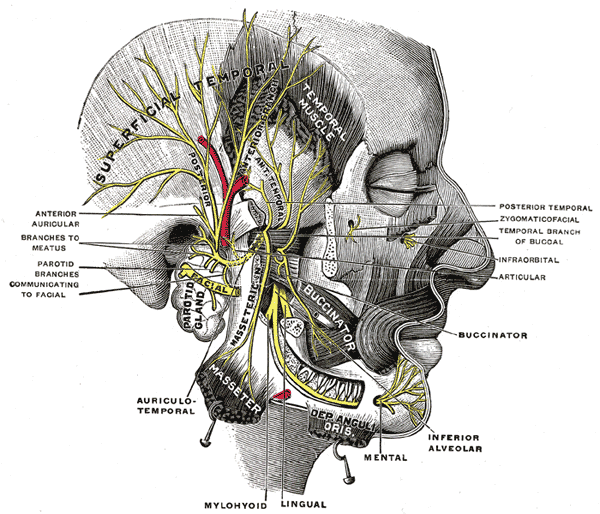Bell's palsy
| Bell's palsy | |
 | |
|---|---|
| ICD-10 | G51.0 |
| ICD-9 | 351.0 |
| DiseasesDB | 1303 |
| MedlinePlus | 000773 |
| MeSH | D020330 |
|
Bell's palsy Microchapters |
|
Diagnosis |
|---|
|
Treatment |
|
Case Studies |
|
Bell's palsy On the Web |
|
American Roentgen Ray Society Images of Bell's palsy |
For patient information click here
Editor-in-Chief: Gilbert Abou Dagher, M.D.
Overview
Historical Perspective
Classification
Pathophysiology
Causes
Differentiating Bell's palsy from other Diseases
Epidemiology and Demographics
Natural History, Complications and Prognosis
Diagnosis
Treatment
History and Symptoms
Sudden onset, usually over hours, of unilateral facial paralysis(maximal symptoms by 48 hours)
- Eyebrow sagging with inability to close the affected eye
- Nasolabial fold flattening with mouth drawn to the non affected side
- Inability to wrinkle forehead (peripheral lesion)
- May be associated with ear pain, impaired taste sensation on the anterior two-thirds of the tongue, decreased tearing, and hyperacusis
Diagnostic Tests
- Electrodiagnostic studies help determine the prognosis, and imaging studies can define potential surgical causes of facial palsy.
- These tests are not necessary in all patients.
- Patients with a typical lesion that is incomplete and recovers do not need further study.
- Electrodiagnostic studies (EMG, or motor nerve conduction study) and Imaging (CT, or MRI) are needed if the physical signs are atypical, there is slow progression beyond three weeks, or if there is no improvement at six months.
- Screening blood studies for an underlying systemic disease or infection may also be considered in these cases.
- There is no test that provides prognostic information early enough to be used for guiding treatment or prognosis.
Risk Stratification and Prognosis
- The House-Brackmann grading system was devised both as a clinical indicator of severity and also an objective record of progress.
- Clinically incomplete lesions tend to recover.
- The natural history without treatment was described in a study of 1011 patients in 1982:
- 67% had incomplete paralysis, with 94% rate of return to normal function
- 33% had complete paralysis, with 60% rate of return to normal function
- By 3 weeks, 71% had complete recovery, 13% had slight sequelae , and 16% had residual weakness
- Herpes zoster is associated with more severe paresis and worse prognosis compared with "idiopathic" Bell's palsy.
- There is a favorable prognosis if some recovery is seen within the first 21 days of onset.
- In severe lesions that recover, the outgrowth of new axons from the injury site may be disorganized and misdirected.
- On blinking there is twitching of the angle of the mouth, and on smiling the eye may close or wink.
- With misdirected autonomic fibers, a salivary stimulus may result in excess lacrimation, the syndrome of "crocodile tears."
- Recurrent attacks of on either the ipsilateral or contralateral side have been observed in 7 to 15% of patients.
References
Additional Resources
- Sullivan FM, Swan IRC, Donnan PT, et al. Early treatment with prednisolone or acyclovir in Bell's palsy. N Engl J Med 2007;357:1598-1607.
- "The Merck Manual"
- New England Journal of Medicine, Sept. 2004
- Lambert, Michael. (2007-03-05) "Bell's Palsy." (Website.) Emedicine. Retrieved on 2007-09-27.
External links
- managment and treatment of facial paralysis
- Bell's Palsy Information Site, has a FAQ
- Bell's Palsy and Pregnancy
- Bell's Palsy Patient Info - Neurology Channel
- Living with Facial Palsy, a site for parents of children with Facial Palsy
- Links to pictures of Bells palsy (Hardin MD/Univ of Iowa)
- Bell's Palsy Association
Template:PNS diseases of the nervous system
ar:شلل العصب الوجهي ca:Paràlisi de Bell de:Fazialislähmung nl:Aangezichtsverlamming van Bell fi:Bellin halvaus Template:WH Template:WikiDoc Sources